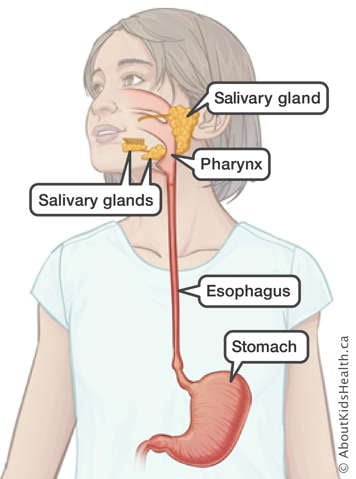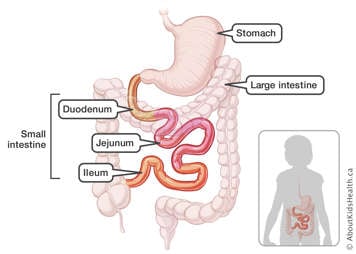
When you eat, your body turns the food into energy and extracts vitamins, minerals and other nutrients to help it work properly. This process is called digestion. The parts of the body that are involved in digestion are called the digestive system.
The central part of the digestive system is a winding muscular tube called the GI (gastrointestinal) tract.
Other parts of the digestive system, called accessory organs, help the GI tract to digest food. They include the:
- liver
- gall bladder
- pancreas.
The GI tract, or digestive tract, has two main parts:
- the upper digestive tract
- the intestines.
Upper digestive tract

The upper digestive tract includes the mouth, the esophagus and the stomach.
Mouth
The mouth is where digestion begins. Even before we eat, the sights and smells of food trigger salivary glands in our cheeks and jaw to release saliva.
Saliva has two roles when we eat.
- It contains digestive juices called enzymes to break down the starch in food.
- It helps to form the food into a compact "glob" called a bolus in our mouth. This makes the food easier to swallow.
Esophagus
When food leaves the mouth, it passes through the pharynx into the esophagus. The esophagus is the muscular tube that gradually pushes food down to the stomach. It does this through waves of contractions known as peristalsis.
The wall of the esophagus releases a thick, sticky liquid called mucus. This mucus helps the body absorb the food you eat. It also lubricates the esophagus so food moves easily to the stomach.
Stomach
The stomach is a bean-shaped, hollow muscular organ that contains digestive acids. These acids help to break down food some more and turn it into liquid. The walls of the stomach are thick and elastic.
The size of the stomach depends on a person's size and body type and how much and how recently they have eaten.
The upper part of the stomach mainly stores food and relaxes to allow food to enter from the esophagus. In the lower part of the stomach, food is broken down through mechanical and chemical digestion.
- Mechanical digestion means that the stomach mixes, churns and pummels food using its muscles. This turns the food into a thick liquid paste called chyme.
- Chemical digestion uses gastric juice to break down the protein in food. This gastric juice is a mix of chemicals and water and is very acidic.
These processes account for part of digestion. The rest of digestion happens in the intestines.
Intestines
Small intestine
Food first passes into the small intestine. This long, hollow tube breaks down food through mechanical and chemical digestion and allows the food to pass into your blood.
The small intestine gets its name only because it is narrow. In fact, in an average adult, it measures about 22 feet (seven metres)!
The small intestine has three parts.
- The duodenum is where most of the remaining chemical digestion takes place. Chemicals and digestive juices from the liver, gall bladder and pancreas help in this process.
- The jejunum is where carbohydrates and proteins pass into the blood.
- The ileum is where vitamin B12 and bile salts pass into the blood.

By this time, food has been broken down into its smallest, most basic units and is ready to be absorbed. The small intestine has a large surface area for this function due to its special folds and tiny, finger-like projections, called villi.
Once food passes through the walls of the small intestine, it separates. Carbohydrates, proteins and some fats go to the liver to be processed. The remaining fats go into the blood.
Large intestine
The large intestine is sometimes called the colon. In adults, it is about five feet (1.5 metres) long.
Its role in digestion is to absorb the water from any leftover undigested food. It is also home to gut flora, which help us digest food and protect us from infections.
Three bands of muscle on the surface of the large intestine move waste products along by waves of contractions called mass movements. When there is enough waste material in the colon, further contractions push the feces (poo) into the rectum before it is released through the anus.
Just for Kids
Your child can learn about digestion by checking out the Belly Bonanza cartoon in our Just for Kids section.
